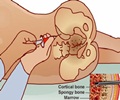
Unlike consumer digital cameras and the human eye, which only see red, green and blue light, a relatively narrow portion of the electromagnetic spectrum, each pixel of a hyperspectral image captures information for hundreds of narrow spectral bands—from the ultraviolet to the infrared.
According to NIST researcher David Allen, being sensitive to so many wavelengths means hyperspectral imagers can see many different things that humans can't see, including the amount of oxygen in human tissues, an indicator of healing.
"The potential of the technology has been proven, but the problem is that researchers are simply lacking a way to assure consistent results between labs," says Allen. "Standards development has itself been hindered by a lack of human skin reflectance data, especially in the ultraviolet and short-wave infrared."
Catherine Cooksey, the project leader for the spectrophotometry program that establishes and maintains the national scale of reflectance, says that before we delve into what diseased tissue looks like hyperspectrally, we need to know what so-called "normal" tissue looks like. Furthermore, she says that they are looking to quantify the variability both within an individual and between individuals due to inherent biological differences. The initial NIST studies used 28 volunteer test subjects. The data collected included a photograph of the test area on the subject's forearm and three reflectance measurements of the test area.
"Skin reflectance varies due to skin pigmentation, tissue density, lipid content and blood volume changes," says Cooksey. "And few, if any, studies of skin reflectance have been done with an estimated measurement uncertainty that is traceable to NIST or any other national metrology institute. We need good data from a wide variety of sources, and for that we need the help of our colleagues in the community."
Advertisement
Source-Eurekalert









